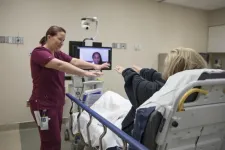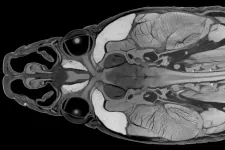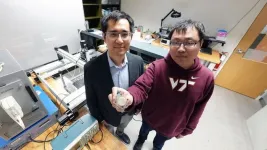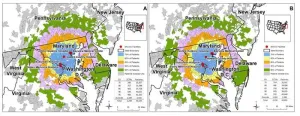(Press-News.org) F. William Studier of Brookhaven National Laboratory has won the second annual Richard N. Merkin Prize in Biomedical Technology for his development of an efficient, scalable method of producing RNA and proteins in the laboratory. His T7 expression technology can be used to make large quantities of nearly any RNA or protein and has been for decades, and continues to be, a mainstay of biomedical research and pharmaceutical production. The approach has been used to produce numerous therapeutics, diagnostics, and vaccines — including the COVID-19 mRNA vaccines credited with extending millions of lives in recent years.
“F. William Studier’s brilliant work on the T7 system transformed biomedicine, saving millions of lives globally and improving the chances for further research that will change healthcare delivery,” said Dr. Richard Merkin, CEO and Founder of Heritage Provider Network, one of the country’s largest physician-owned integrated health care systems. “His work exemplifies why I created this prize initiative that honors and showcases amazing innovators like Bill. I’m honored to be celebrating his remarkable achievements.”
The Merkin Prize, which recognizes novel technologies that have improved human health, carries a $400,000 cash award and is administered by the Broad Institute of MIT and Harvard, one of the world’s leading biomedical research institutes. All nominations for the 2024 Merkin Prize were evaluated by a selection committee, composed of nine scientific leaders from academia and industry in the US and Europe. Studier will be honored in a prize ceremony held on September 17, 2024.
“The T7 system has been influential in biomedicine and has had important clinical implications for many years, but Bill Studier’s contribution to the field has really not been as celebrated as it ought to be,” said Harold Varmus, chair of the Merkin Prize selection committee. Varmus is also the Lewis Thomas University Professor at Weill Cornell Medicine, a senior associate at the New York Genome Center, and a recipient of the Nobel Prize in Physiology or Medicine for his work on the origins of cancer.
“Bill Studier’s development of T7 phage RNA polymerase for use in preparing RNA templates for multiple uses in research labs worldwide has been a truly revolutionary technical advance for the entire field of molecular biology,” said Joan Steitz, the Sterling Professor of Molecular Biophysics and Biochemistry at Yale University.
“Today, virtually every protein you want to produce in bacteria is made with a T7 system,” said Venki Ramakrishnan of the MRC Laboratory of Molecular Biology in Cambridge, England, and a winner of the 2009 Nobel Prize in Chemistry. “There’s not a single molecular biology or biochemistry lab I know that doesn’t use T7.”
Driven by basic biology
Studier grew up in Iowa and became fascinated with biophysics while an undergraduate at Yale University. Then, during graduate school at the California Institute of Technology in the early 1960s, he was introduced to bacteriophage T7, a virus that infects Escherichia coli bacteria. He wondered how T7 could so effectively and quickly take over E. coli, rapidly turning the bacterial cells into factories to produce more T7. That question launched a career focused on the basic biology of T7.
“I've always been interested in solving problems,” Studier told Brookhaven National Laboratory in a 2011 profile. "The motivation for my research is not commercial application. My interest is in basic research."
When he launched his own lab at Brookhaven National Laboratory in 1964, Studier focused on sequencing the genes of the T7 bacteriophage and understanding the function of each of its corresponding proteins during infection of E. coli. By 1984, he and Brookhaven colleague John Dunn successfully identified and cloned the protein within T7 that was responsible for rapidly copying T7 DNA into many corresponding strands of RNA — a critical step in the bacteriophage’s ability to infect E. coli.
Studier realized that the protein, called the T7 RNA polymerase, might be able to quickly and efficiently produce RNA from not only T7 DNA, but also from the genes of any organism. If a gene was tagged with a special DNA sequence, known as the T7 promoter, then the T7 RNA polymerase would latch on and begin copying it. In 1986, Studier described this system in the Journal of Molecular Biology.
“His work really illustrates that sometimes a remarkable technology can emerge not only from people trying to build technologies but from someone who is trying to use basic science to understand a fascinating biological phenomenon,” said Varmus.
Speeding science
Before Studier’s development of the T7 system, scientists who wanted to produce RNA or proteins generally inserted the genes into the natural E. coli genome and let the E. coli polymerase produce the corresponding RNA at the same time as the bacteria produced its own RNA and proteins. But the E. coli machinery was relatively slow, and scientists often ran into problems with the bacteria turning off their DNA-reading programs. T7 polymerase overcame both these problems: it was far faster and E. coli had no built-in way to shut it off.
Within a few years, biologists had rapidly switched from their older methods to the T7 system for producing both RNA and proteins. When proteins are the desired end result, the E. coli molecular machinery for translating mRNA into proteins is used after the T7 system makes the RNA.
Studier continued studying the T7 polymerase and promoter, fine-tuning the system for years, and publishing new improved versions as recently as 2018.
As of 2020, the T7 technology had been cited in more than 220,000 published studies, with 12,000 new studies using the technology published each year. There are more than 100 different versions of the T7 technology available commercially and 12 patents in Studier’s name related to the system.
Making medicine
The T7 technology has also had immediate impacts in industry, with more than 900 biotech and pharmaceutical companies licensing it to produce therapeutics and vaccines.
In 2020, scientists used the T7 platform to produce enough mRNA for COVID-19 vaccines to vaccinate millions of people in the U.S. and around the world. With the T7 promoter placed next to the gene for the COVID-19 spike protein, the T7 polymerase could generate many kilograms of mRNA — the active molecule in the vaccines — at a time.
“I think it’s an incredible testament to this technology that, decades after its development, it’s still the go-to method for RNA and protein production,” said John Shanklin, a distinguished biochemist and Chair of Biology at Brookhaven National Laboratory, who considered Studier a mentor for many years.
Those who know Studier say the Merkin Prize is well-deserved; Studier changed the course of biomedicine while working quietly on basic science questions that interested him.
“Almost no one has heard of Bill Studier because he is a quiet, modest guy who had a small lab,” said Ramakrishnan, who worked with Studier at Brookhaven in the 1980s. “But he is an absolutely fantastic role model of what a scientist should be like.”
“He has flown under the radar and hasn’t been recognized for his accomplishments very much,” agreed Shanklin. “This is a well-deserved honor."
Studier was also committed to guaranteeing access to his technology. When Brookhaven was in the process of licensing and commercializing the T7 system shortly after its development, Studier ensured that it remained free for academic labs while charging commercial licensing fees to companies.
Studier is a Senior Biophysicist Emeritus at Brookhaven National Laboratory and has been elected to the American Association for the Advancement of Science, the American Academy of Arts and Sciences, and the National Academy of Inventors. He retired from the lab in 2015 and lives with his wife in California, where he still plays tennis at age 88.
Nominations for the 2025 Merkin Prize open on August 5, 2024. Visit merkinprize.org for more information.
END
Merkin Prize in Biomedical Technology awarded to F. William Studier for development of widely used protein- and RNA-production platform
The $400,000 award recognizes the far-reaching medical impacts of Studier’s development, in the 1980s, of an efficient and scalable technology to produce mass amounts of RNA and proteins in laboratories that is widely used today all over the world.
2024-05-22
ELSE PRESS RELEASES FROM THIS DATE:
Geisinger funding renewed for familial hypercholesterolemia research
2024-05-22
DANVILLE, Pa. – Geisinger has been awarded $3 million from the National Heart, Lung and Blood Institute of the National Institutes of Health to continue its research on familial hypercholesterolemia (FH). The new funding will build on Geisinger’s ongoing work to improve communication with patients with FH and their family members and increase early screening and diagnosis.
FH is an inherited condition that causes high levels of low-density lipoprotein (LDL) cholesterol, often referred to as “bad cholesterol.” Left untreated, high ...
Solar physicists unlock the key to how sunspots form—and much more
2024-05-22
A team of solar scientists have uncovered the possible originals of the engine that drives much of the sun’s volatile nature—generating the sunspots that move like storm clouds over the surface and causing the sun’s activity levels to rise and fall over 11-year cycles.
The secret behind this engine, also known as the “solar dynamo,” may be among the oldest “unsolved problems of physics,” said Benjamin Brown, a solar physicist at CU Boulder.
In new research, he and his colleagues used mathematical equations ...
Stroke-care metrics improve with stroke center certification and coordinators
2024-05-22
Key stroke-care metrics improve at telestroke hospitals with stroke center certification and stroke coordinators.
That’s what NORC researchers at the University of Chicago found when they conducted an external evaluation of the telestroke program at the Medical University of South Carolina. NORC, which stands for National Opinion Research Center, and MUSC researchers report their findings in the Journal of Stroke & Cerebrovascular Diseases.
Mithuna Srinivasan, Ph.D., principal research scientist at NORC, is the lead author of the article and MUSC telestroke and telehealth experts Christine Holmstedt. D.O., Jillian Harvey, Ph.D., ...
Young people are increasingly using Wegovy and Ozempic
2024-05-22
Public interest in weight loss drugs like Wegovy and Ozempic is surging, but national data on dispensing patterns in the United States are surprisingly scarce.
Now, a national study from Michigan Medicine shows that the use of these weight loss drugs is increasing rapidly in adolescents and young adults 12-25 years, especially females.
Using 2020 - 2023 data from a national database representing 92% of pharmacies, the study team found a 594% increase in the monthly number of adolescents and young adults using Wegovy, Ozempic, and other glucagon-like peptide-1 receptor agonists ...
UArizona Health Sciences professor uses CT network to promote public access to open science
2024-05-22
Reading about the latest scientific discovery – such as the unearthing of a fossil representing a new species of tiny dinosaur – can be fascinating. But what if it were possible to do more than just read about it? What if you could go online, download a digital model and 3D print an exact replica of that fossil within minutes of reading the news? That is the goal of the Non-Clinical Tomography Users Research Network, or NoCTURN, an international group of researchers spearheaded by theUniversity of Arizona Health Sciences, the American ...
Designing autism-inclusive healthcare environments
2024-05-22
Autism is the most common neurodevelopmental disorder in the U.S., affecting an estimated one out of 36 children. Most people with autism experience unique sensory features such as differences in reactivity to touch, sounds, and sights or difficulty managing multiple sensory inputs at the same time.
These sensory differences can make the healthcare environment — often characterized by fluorescent lights, idle waiting rooms and uncomfortable pokes and prods — difficult to navigate, preventing children with autism from getting the care they need. To change that, occupational therapists Roseann ...
Zhenhua Tian receives National Science Foundation CAREER award to develop invisible acoustic tweezers
2024-05-22
Medical procedures capable of moving cells inside the body without making incisions have unique benefits. From faster recovery times to less trauma impacting the body, the list of reasons to do surgery without scalpels is growing with the technology used to perform noninvasive treatments.
A new method that might be available in the future is coming to life through research conducted by Zhenhua Tian’s team. The assistant professor in the Department of Mechanical Engineering is using tube-shaped acoustic energy to capture tiny biological ...
Community science volunteers can set scientific world abuzz with new bumble bee sightings
2024-05-22
TORONTO, May 22, 2024 – Community science volunteers – laypeople with an interest in bees and conservation – significantly contribute to the scientific knowledge of native bumble bees across Canada and the United States, finds a new study by York University.
It’s buzz worthy confirmation that community science programs can play an important role in monitoring the changing distributions of bumble bees and more. Community scientists have importantly also detected several at-risk or endangered species in unexpected locations, including the rusty-patched bumble bee and the gypsy cuckoo bumble bee. Trained scientists often haven’t seen some ...
Proximity to a cancer center contributes to cancer stage at diagnosis, study finds
2024-05-22
Location, race and insurance status play a significant part in the odds of a patient being diagnosed with early-stage or late-stage cancer, according to a detailed medical records analysis of more than 94,000 patients with cancer by researchers at the Johns Hopkins Bloomberg School of Public Health and the Johns Hopkins Kimmel Cancer Center.
Patients who lived farther away from a facility designated a comprehensive cancer center (CCC) by the National Cancer Institute (NCI) and who received only a diagnosis or only treatment at the center had higher than average odds of a late-stage diagnosis, ...
Study suggests it may be safe to de-escalate surgery in middle-aged breast cancer patients
2024-05-22
Surgery involving sentinel lymph node biopsy for middle-aged women with estrogen receptor-positive (ER+) breast cancer may do more harm than good, according to a new study led by University of Pittsburgh and UPMC Hillman Cancer Center researchers. The team used a novel artificial intelligence pipeline developed by Realyze Intelligence, a UPMC Enterprises portfolio company, to analyze electronic health records.
The findings, published today in JCO Clinical Cancer Informatics, suggest that clinical guidelines for de-escalating surgery in women aged over 70 years with early-stage ER+ breast cancer may be safely ...
LAST 30 PRESS RELEASES:
Valvular heart disease is common in cancer patients but interventions improve survival
When socially responsible investing backfires
Cuffless blood pressure technologies in wearable devices show promise to transform care
AI-based tool predicts future cardiovascular events in patients with angina
Researchers map how the cerebellum builds its connections with the rest of the brain during early development
Routine scans could detect early prostate radiotherapy changes
Fairness in AI: Study shows central role of human decision-making
Pandemic ‘beneath the surface’ has been quietly wiping out sea urchins around the world
Tea linked to stronger bones in older women, while coffee may pose risks
School feeding programs lead to modest but meaningful results
Researchers develop AI Tool to identify undiagnosed Alzheimer's cases while reducing disparities
Seaweed based carbon catalyst offers metal free solution for removing antibiotics from water
Simple organic additive supercharges UV treatment of “forever chemical” PFOA
£13m NHS bill for ‘mismanagement’ of menstrual bleeds
The Lancet Psychiatry: Slow tapering plus therapy most effective strategy for stopping antidepressants, finds major meta-analysis
Body image issues in adolescence linked to depression in adulthood
Child sexual exploitation and abuse online surges amid rapid tech change; new tool for preventing abuse unveiled for path forward
Dragon-slaying saints performed green-fingered medieval miracles, new study reveals
New research identifies shared genetic factors between addiction and educational attainment
Epilepsy can lead to earlier deaths in people with intellectual disabilities, study shows
Global study suggests the underlying problems of ECT patients are often ignored
Mapping ‘dark’ regions of the genome illuminates how cells respond to their environment
ECOG-ACRIN and Caris Life Sciences unveil first findings from a multi-year collaboration to advance AI-powered multimodal tools for breast cancer recurrence risk stratification
Satellite data helps UNM researchers map massive rupture of 2025 Myanmar earthquake
Twisting Spins: Florida State University researchers explore chemical boundaries to create new magnetic material
Mayo Clinic researchers find new hope for toughest myeloma through off-the-shelf immunotherapy
Cell-free DNA Could Detect Adverse Events from Immunotherapy
American College of Cardiology announces Fuster Prevention Forum
AAN issues new guideline for the management of functional seizures
Could GLP-1 drugs affect risk of epilepsy for people with diabetes?
[Press-News.org] Merkin Prize in Biomedical Technology awarded to F. William Studier for development of widely used protein- and RNA-production platformThe $400,000 award recognizes the far-reaching medical impacts of Studier’s development, in the 1980s, of an efficient and scalable technology to produce mass amounts of RNA and proteins in laboratories that is widely used today all over the world.





